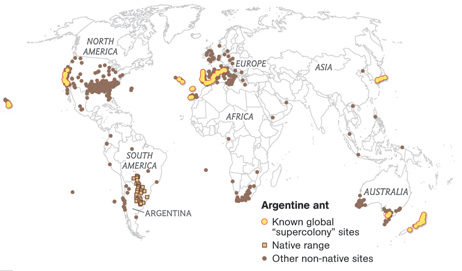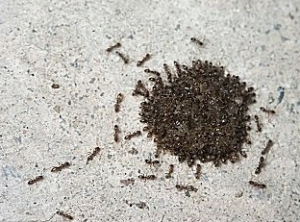Argentine ants are not native to the United States but were brought here in the 1890’s and are considered a serious invading home invading pest. This small brown ant (2-3 mm in length) looks very similar to other ants but its habits of area and specie domination have put in the top 100 list of most invasive insect. Argentine ants do not tolerate other species of ants which can throw the balance off of an area and other creatures also suffer with their presence. Lizards in California for example that depend on other ants for food have declined in population with the take over of this dominate pest. Normally brown in color, shiny and almost completely hairless this non de-script ant is best identified by its behavior.
Argentine ants will nest almost anywhere. Under cement slabs, wood piles or debris, potted plants and even underground. The nest site changes quite often with the availability of food and water. The colony will have many queens but they rarely swarm preferring to mate inside the nest. They do not sting but can and will bite. This aggressive ant drives out other ant competition and will even devour whole termite or bee colonies.
The argentine ant readily enters our homes through very tiny cracks or gaps. This efficient ant lays down scent trails not only from the nest to a food source but also to areas that have been explored before. Thousands descend on found food sources but are mainly attracted inside your home for water. This ant is fond of sweets but will readily make a meal out of other insects, meats, garden and other organic matter. Their shear numbers often out pace pest control efforts and professional help is recommended.
How They Move
This ant was believed to be brought to America in coffee ships from Brazil to New Orleans and still travels much the same today. It is often found as a stow away in trucks, moving vans or shipments. Colonies can easily reach the million or more range and this allows them to dominate their territory. DNA in the argentine ant is also unique in that separate colonies have ‘merged’ because the ants recognize other argentine ants and they mingle, co-habit and spread together. This ability has made way for “super colonies” that can stretch for thousands of miles.
found as a stow away in trucks, moving vans or shipments. Colonies can easily reach the million or more range and this allows them to dominate their territory. DNA in the argentine ant is also unique in that separate colonies have ‘merged’ because the ants recognize other argentine ants and they mingle, co-habit and spread together. This ability has made way for “super colonies” that can stretch for thousands of miles.
How Best To Identify Argentine Ants
Since this ant has no readily visible markings you may need to have a professional ID this specie of ant. It is a very small ant about 2 to 3 mm and is shiny brown to black in color. It is noted for it’s endless single line of foragers and huge numbers that swarm a food source and once an area is cleared they rarely visit it twice. There are no soldiers ants in the colony and all argentine ants are the same size.
Range
Argentine ants are heaviest in wet areas and are mostly confined to coastal states but have spread out to invade near by areas. From California to Florida and as far up as the Carolinas this ant has been reported. Colonies have also been found in Washington State near Puget Sound and even Illinois.
Treatment And Elimination
It is for the most part impossible to eliminate this ant due to its huge numbers and ‘super colony’ effect. Keeping them out of your home can be achieved but returning ants is always possible. Pest proofing is always helpful but difficult to seal all the tiny cracks, gaps and voids these ants can use. Caulk or seal as much as possible. Reducing water sources is a main key to deter this ant. Rerouting a/c lines away from  the home, stopping leaky spigots and keeping pet dishes elevated is helpful. Finding nest sites and destroying the ants is an excellent way to relieve ant ‘pressure’ from around a home.
the home, stopping leaky spigots and keeping pet dishes elevated is helpful. Finding nest sites and destroying the ants is an excellent way to relieve ant ‘pressure’ from around a home.
Exterior liquid treatments with Bifen IT works well around windows, doors, entry points and the base of the home. Granule barriers with Talstar also provide some protection. Interior sprays using Suspend SC or Demand are good to repel ants as well as dusts in voids using Borid, DE (diamataceous earth), Delta or Drione. Ant baits such as Advion gel or Terro placed in cracks, crevices or pathways will also work.




